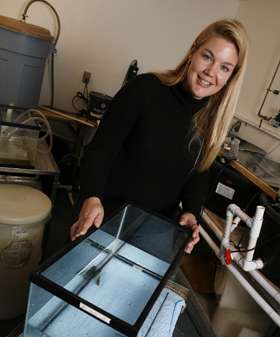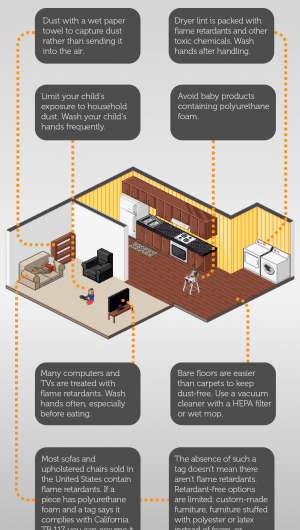Flame retardants make dust bunnies dangerous: Chemicals in dust are as concentrated as in sewage sludge

"If you really look at what's in your dust, particularly for some chemicals, it's just as concentrated—or more—as what you'd find in sewage sludge," says Heather Stapleton, associate professor of environmental chemistry.
The chemicals she's talking about are flame retardants, which she has found in the dust of every one of the several hundred homes she's tested. The chemicals come into our houses via treated furniture, electronics, and insulation. Over time they accumulate in our dust. And in our bodies. Virtually all Americans have flame retardants in their blood, and at much higher levels than people in other countries.
Fire retardants are in our homes because of public policy aimed at preventing fire deaths, but they've been accused of mimicking hormones affecting brain development in children or altering DNA in ways that lead to cancer.
Since arriving at Duke in the fall of 2005, Stapleton has become a leading expert in the matter of flame retardants. A tall young woman with long blond hair pulled back in a ponytail, Stapleton speaks quickly yet quietly, using words with perhaps the same efficiency that allows her to win funding, do research, and publish papers at a prodigious rate.
"The types of things she's working on and publishing are actually making a difference in terms of public policy," says collaborator Susan Murphy of the medical school, who describes Stapleton as "effective," "remarkable," and "a really nice person, too."
A mother of two, Stapleton is particularly concerned about the effects of flame retardant chemicals on children, whose brains and bodies are still developing. Children often have higher levels of flame retardant chemicals in their bodies than adults, probably because they spend more time on the floor and frequently put things—including their hands—in their mouths.
In an NIH-funded study published last year, Stapleton developed a technique to use hand wipes to measure the amount of flame retardant chemicals on toddlers' hands, and discovered that this was a good predictor for the levels in their blood. This suggests that the hand-to-mouth route is the biggest exposure pathway for toddlers, and by extension, perhaps for all of us.
Flame retardants have not always been so ubiquitous. In 1975, California passed Technical Bulletin 117 requiring furniture to meet a flammability standard, which led to every piece of polyurethane foam in furniture sold in California containing flame retardants. Even among Americans, Californians stand out for the high levels of flame retardant chemicals in their blood.
Because of the influence of California's giant market, most polyurethane foam in furniture sold throughout the United States contains flame retardants.
Proposed changes were recently written for TB 117, in a process that was informed partly by Stapleton's research, and put out for public comment. If the policy changes are adopted, furniture makers would be able to conform to the standard without adding flame retardants to foam. The state's Bureau of Home Furnishings is taking the comments under consideration and is expected to release recommendations around the beginning of 2014.
In a 2012 study, Stapleton used mass spectroscopy to analyze foam from 102 sofas bought in the United States between 1985 to 2010. She found 85 percent of them contained one or more flame retardant chemicals. Among older sofas, those bought in California were more likely to contain flame retardants, but almost all the newer sofas contained flame retardants regardless of where they were bought. The study was funded by NIH and a private donation from Fred and Alice Stanback.

Stapleton's concern for her own toddlers fuels her passion. At work, she looks for the presence of flame retardant chemicals in samples of foam, house dust, urine, and blood, and she studies the effects of these chemicals on zebrafish, rats, and humans. At home, she washes her children's hands often, keeps household dust to a minimum, and tries to avoid buying furniture and baby products treated with flame retardants.
If Stapleton feels overwhelmed by the information she's discovering, or the mountain of work yet to do, she doesn't show it. "You have to take it in stride. There are some things we can't control," she says. "All I can do is do my best to conduct the best research possible, that might help bring about change in the future."
"She is a brilliant young scientist who often steps out beyond her level of comfort to move into new areas," says NIEHS Director Linda Birnbaum, who has been a mentor to Stapleton.
The proven and potential health effects of flame retardant chemicals are unsettling. A class of flame retardants called PBDEs are structurally similar to thyroid hormones and can mimic them in the body. Thyroid hormones are crucial not only to metabolism in adults, but to brain development in children. Studies of animals and long-term studies of children have shown associations between high levels of PBDEs and significant problems with attention, learning, memory, and fine-motor control. Certain types of PBDEs were phased out in 2005, and another type is being phased out this year, but that still leaves us with lots of sofas and armchairs containing PBDEs in our homes.
The same goes for a flame retardant called chlorinated tris, which was phased out for use in children's pajamas in the 1970s because it causes mutations in human DNA. The EPA calls it a "moderate cancer risk." Stapleton found chlorinated tris in a quarter of the sofas in her study. In sofas bought in 2005 or later, the proportion rose to just over half, suggesting that manufacturers are using tris more as they use PBDEs less.
Stapleton also discovered tris in baby products. She sampled foam from 101 baby products including changing pads, nursing pillows, and car seats. More than 80 percent of the products contained flame retardants, and more than a third contained tris. Her 2011 paper on this study was named the top paper of the year by Environmental Science and Technology.
"Infants are in intimate contact with these products for 24 hours a day. They are getting the highest exposure and no risk characterizations are being conducted for infants," says Stapleton.
Stapleton also identified two flame retardant chemicals in the baby products that have not been previously documented. "We need to have a better idea of what chemicals are used as flame retardants, so we can better inform future studies on human exposure," she says.
Unfortunately, unless you are a chemist with a mass spectrometer, there is no way to know what flame retardants, if any, are present in any particular product. Stapleton says furniture and foam manufacturers often do not know themselves what chemicals are in the foam. And the chemical companies that make the flame retardants don't have to share their recipes with the public.
The ingredients of Firemaster 550—in use since 2003—were a secret until 2008, when Stapleton and colleagues used their chemical know-how to figure it out. Two of its ingredients are structurally similar to other chemicals known to interfere with hormones.
To test that idea, Stapleton and N.C. State University professor Heather Patisaul fed pregnant rats Firemaster 550 in a small pilot study funded by NIH. "The doses we used were an order of magnitude lower than what chemical companies said were safe," Stapleton says.
The offspring of these rats were anxious, showed early signs of puberty, and were markedly heavier than baby rats whose mothers hadn't had any Firemaster 550.
"They were 30% heavier than the controls; they were literally obese," Stapleton says. "It's fascinating to me in one way and scary in another, because our research shows almost all kids are exposed to these chemicals on a daily basis." She's found Firemaster 550 in more than 95% of the homes she's tested.
But surely the benefits of flame retardants outweigh the risks, right? Wrong. "There is no data whatsoever demonstrating that the use of these chemicals in furniture or baby products does anything to reduce hazards from fire," Stapleton says. "And some data suggest they could provide increased hazards—when they do burn, they generate more smoke, soot, and carbon monoxide."
Rates of death by fire have decreased in the United States—at similar rates in all states, not just California—for a variety of reasons, including a decrease in smoking, many more smoke alarms, and fire-safe cigarettes. (For more on health effects, read this sidebar.)
In July 2012, Stapleton testified before the U.S. Senate Committee on Environment and Public Works, to encourage the overhaul of TSCA (Toxic Substances Control Act), a law passed in 1976. As it currently stands, manufacturers notify EPA when they begin marketing a new chemical, but are not required to provide data regarding safety. A revised TSCA might also give consumers the freedom to make choices about flame retardants. Stapleton supports TSCA reform. "I think a parent has the right to know what's in products their babies are sleeping on and touching on a daily basis," she says.
While lawmakers wrestle with TSCA and California's TB 117, Stapleton will continue pushing the scientific frontiers. She's hoping to collaborate soon on some observational studies of children and their exposure to flame retardant chemicals over time. She also wants to spend more time in the lab with zebrafish, figuring out the mechanisms by which these chemicals interfere with biological processes.
















